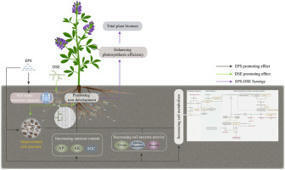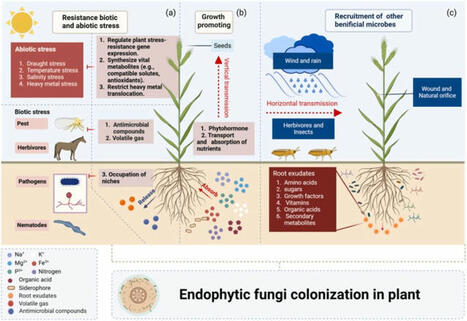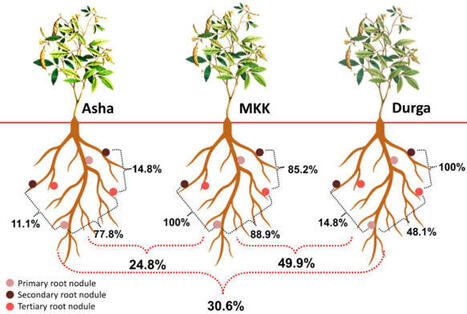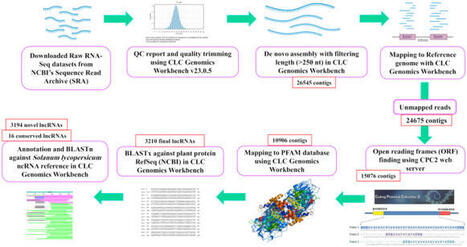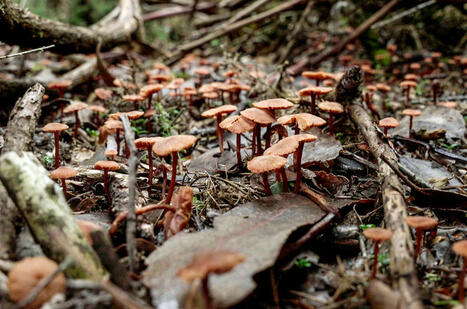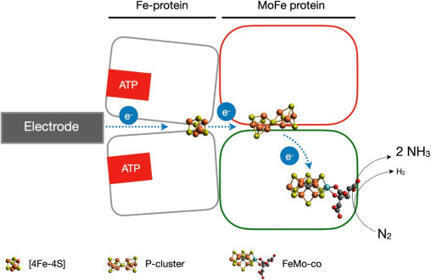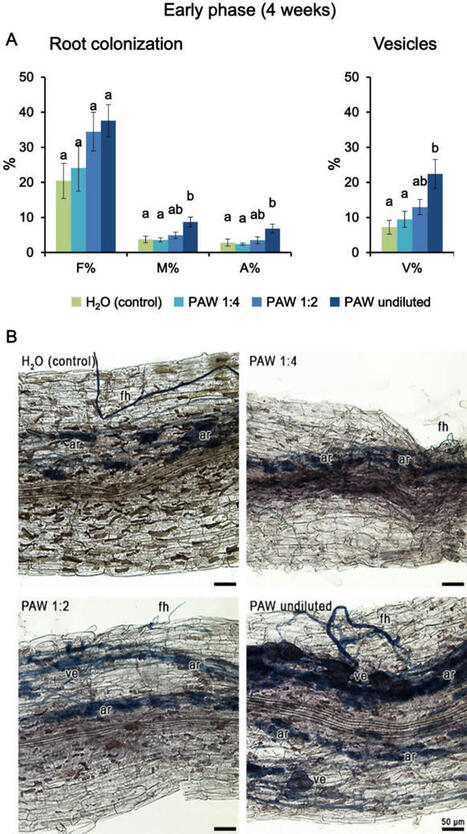 Your new post is loading...
 Your new post is loading...

|
Scooped by
Jean-Michel Ané
Today, 12:10 PM
|
Global losses of agricultural products from water scarcity could be greater than from all other causes combined. Water deficiency in plants can result from insufficient precipitation, elevated air temperatures, and other factors that reduce the water available in the soil. Most terrestrial plants are able to form symbiosis with arbuscular mycorrhizal fungi. Arbuscular mycorrhiza plays a key role in the mineral nutrition of many terrestrial plant species. Water transport in plants is regulated primarily by aquaporins, transmembrane proteins. Aquaporins help plants save water, which is an important component of the plant’s adaptation strategy to water scarcity. Some studies suggest that arbuscular mycorrhizal fungi can decrease the expression of aquaporin genes in plants under drought conditions, which reduces water transport within host plant tissues and conserves available water. On the other hand, there is little scientific evidence of the interaction mechanisms between plants and arbuscular mycorrhizal fungi during aquaporin regulation. In addition, the information in different sources on the aquaporin functions in different plant species may be contradictory. Plant aquaporins are represented by several subfamilies; their number varies for different species. A more comprehensive study of these transporters can enhance our understanding of water transport in plants and assess how arbuscular mycorrhizal fungi can influence it. This review contains data on the history of studies of the structure, localization, phylogeny, and functions of aquaporins.

|
Scooped by
Jean-Michel Ané
Today, 12:06 PM
|
The ecological restoration of mining regions presents significant scientific challenges, particularly concerning poor soil structure and the difficulty of retaining water and nutrients. Dark septate endophytes (DSE) are known to improve soil structure and promote plant growth, yet the precise mechanisms which they operate remain inadequately understood. In this study, extracellular polymeric substances (EPS) were extracted from the metabolites of the DSE (Alternaria sp. 17463) to evaluate their synergistic impact on plant growth when applied as a soil amendment in conjunction with the DSE strain. The application of 0.25% EPS increased soil water retention by 11.02% and stimulated root development by enhancing soil enzyme activity, overall soil metabolism, and nutrient availability. Particularly, the alterations in enzyme activities and nutrient availability within small macro-aggregates were crucial in supporting alfalfa growth. The combined effect of DSE and EPS significantly enhanced soil structure and alfalfa root development, resulting in a remarkable 4.04-fold increase in total biomass. Therefore, these findings provided a theoretical basis for the large-scale application of ecological restoration and microbial technologies.

|
Scooped by
Jean-Michel Ané
Today, 11:59 AM
|
Medicago, a genus in the Leguminosae or Fabaceae family, includes the most globally significant forage crops, notably alfalfa (Medicago sativa). Its close diploid relative Medicago truncatula serves as an exemplary model plant for investigating legume growth and development, as well as symbiosis with rhizobia. Over the past decade, advances in Medicago genomics have significantly deepened our understanding of the molecular regulatory mechanisms that underlie various traits. In this review, we comprehensively summarize research progress on Medicago genomics, growth and development (including compound leaf development, shoot branching, flowering time regulation, inflorescence development, floral organ development, and seed dormancy), resistance to abiotic and biotic stresses, and symbiotic nitrogen fixation with rhizobia, as well as molecular breeding. We propose avenues for molecular biology research on Medicago in the coming decade, highlighting those areas that have yet to be investigated or that remain ambiguous.

|
Scooped by
Jean-Michel Ané
May 1, 5:34 PM
|
Rhizobia are a group of soil proteobacteria that are able to establish a symbiotic interaction with legumes. These bacteria are capable to fix atmospheric nitrogen into ammonia within specific plant root organs called nodules. The rhizobia-legume interaction is established by a complex molecular dialogue that starts with flavonoids exudated by the plant roots. In response, signaling molecules known as Nod factors (NFs) are secreted by the bacteria. These factors are sensed by specific plant receptors that trigger a downstream signaling cascade leading to rhizobium-specific intracellular colonization of the root hair via the formation of infection threads and the eventual development of nodules on roots. In these organs, rhizobia can fix nitrogen from the atmosphere for the plant in exchange for photosynthates and the appropriate environment for nitrogen fixation. Recently, it has been demonstrated that extracellular membrane vesicles (EMVs) produced by some rhizobia carry NFs. EMVs are proteolipidic structures that are secreted to the milieu from the bacterial membranes and are involved in several important biological processes, including intercellular communication. Thus far, little is known about rhizobia vesicles, and further studies are needed to understand their functions, including their role as transporting vessels of signaling molecules during the process of symbiosis. Here, we present a detailed protocol to isolate high-purity EMVs from free-living cultured rhizobia, test their integrity, and quantify their abundance.

|
Scooped by
Jean-Michel Ané
April 29, 1:40 PM
|
Abstract. Field trials of rhizobial inoculants require simple and reliable methods for identifying the strains used to determine which strain has formed a nitrogen-fixing nodule. This task arises when testing the competitiveness of inoculant strains against local rhizobia strains, to track the fate of inoculant strains over long periods after the introduction of strains, and finally, such methods may be in demand when protecting the rights of strain owners and developers. The essence of the proposed identification method is to search for strain-specific DNA regions that are absent in other genomes of the same species and to construct a primer system for multiplex PCR, allowing simple, reliable and rapid identification of the strain. The advantages of this approach over other identification methods are, firstly, high reproducibility, and secondly, that the method is based on the detection of structural variants, the contribution of which to the evolution of rhizobia genomes is very high, while most genomic fingerprinting methods (AFLP, RAPD, REP, ERIC, etc.) are based on the detection of nucleotide polymorphisms in short fragments of the genome, but miss many events associated with genomic rearrangements and horizontal gene transfer. The use of the proposed method can also serve to monitor the evolutionary dynamics of rhizobial inoculant strains, especially in unique fragments of the genome, which is very important for R. leguminosarum, where the proportion of unique sequences is much higher than in other rhizobia.

|
Scooped by
Jean-Michel Ané
April 29, 1:33 PM
|
Soybean (Glycine max) nitrogen fixation is inhibited by nitrate, which has been linked to a reduction in carbon allocation and metabolism within nodules. However, the underlying mechanisms remain unclear. In this study, we tested the hypothesis that the nitrate-induced suppression of nitrogen fixation is mediated through altered sucrose allocation and catabolism in nodules. Using unilaterally nodulated dual-root soybean plants in sand-based systems, we applied 200 mg·L−1 nitrate exclusively to the non-nodulated roots for 14 days. Nitrate supply enhanced the proportion of dry weight in leaves but reduced it in nodules at 3, 7, and 14 days. Similarly, nodule dry weight, nodule number, acetylene reduction activity (ARA), and specific nodule activity (SNA) all declined significantly during the same intervals. Notably, sucrose content in the nodules decreased significantly by 20.4% after 3 days but recovered at 7 and 14 days. In contrast, sucrose synthase (SuSy) cleavage activity and malate content in nodules decreased significantly following nitrate treatment, with reductions of 27.8% and 30.7% observed at 7 days, and further decreased to 38.5% and 39.2% at 14 days, respectively. These results suggest that transient sucrose scarcity may drive the initial decline in nitrogen fixation capacity, while restricted sucrose catabolism and decreased malate levels may be a consequence rather than a cause.

|
Scooped by
Jean-Michel Ané
April 28, 9:30 PM
|
Plants small secreted peptides (SSPs) regulate root development, immunity and symbiotic relationships in herbaceous plants. These processes are equally important for establishing functional ectomycorrhizal associations in trees. While fungal SSPs involved in ectomycorrhizal establishment have been identified, the role of plant SSPs remains largely unexplored. Although thousands of SSPs were predicted in plant genomes, their small size and high sequence divergence hinder their accurate automated annotations. To address this issue, we combined de novo gene prediction with family-specific motif search to identify 1,053 SSPs from 21 symbiosis-related families in the genomes of two ectomycorrhizal tree species: Populus trichocarpa and Quercus robur. Nearly half of these SSPs are transcriptionally regulated during ectomycorrhizal symbiosis with various fungal partners. Functional assays of selected Populus CLE peptides, a SSP family known to repress arbuscular mycorrhizal and rhizobial symbioses, revealed that five enhanced ectomycorrhizal roots formation. Unlike CLEs involved in the autoregulation of arbuscular mycorrhizal and rhizobial symbioses, these peptides belonged to clades associated with meristem activity. Their activity did not increase lateral root number but inhibited adventitious root growth, suggesting their role in promoting ectomycorrhizal root organogenesis. These findings demonstrate that CLE peptides promote, rather than repress, ectomycorrhizal symbiosis. This functional divergence from their roles in other symbioses suggests that poplar co-opted a distinct set of SSPs to support ectomycorrhizal development. Our results expand the understanding of host tree contributions to ectomycorrhizal development and identify a set of candidate SSPs for future functional studies, thereby highlighting a new layer of regulation in tree-fungal mutualism.

|
Scooped by
Jean-Michel Ané
April 28, 9:25 PM
|
Restoration of soil microbial communities, and microbial mutualists in particular, is increasingly recognized as critical for the successful restoration of grassland plant communities. Although the positive effects of restoring arbuscular mycorrhizal fungi during the restoration of these systems have been well documented, less is known about the potential importance of nitrogen‐fixing rhizobium bacteria, which associate with legume plant species that comprise an essential part of grassland plant communities, to restoration outcomes. In a series of greenhouse and field experiments, we examined the effects of disturbance on rhizobium communities, how plant interactions with these mutualists changed with disturbance, and whether rhizobia can be used to enhance the establishment of desirable native legume species in degraded grasslands. We found that agricultural disturbance alters rhizobium communities in ways that affect the growth and survival of legume species. Native legume species derived more benefit from interacting with rhizobia than did non‐native species, regardless of rhizobia disturbance history. Additionally, slow‐growing, long‐lived legume species received more benefits from associating with rhizobia from undisturbed native grasslands than from associating with rhizobia from more disturbed sites. Together, this suggests that native rhizobia may be key to enhancing the restoration success of legumes in disturbed habitats.

|
Scooped by
Jean-Michel Ané
April 28, 9:15 PM
|
• Endophytic fungi exhibit remarkable host diversity and global distribution, enabling widespread ecological interactions.
• Endophytic fungi, crucial helpers for their hosts, aid in plants adapting to diverse stresses in the external environment.
• Endophytic fungi establish symbiotic relationships with their hosts through a delicate and intricate process.
• Endophytic fungi promote plant growth through enhanced nutrient uptake and metabolic rewards.

|
Scooped by
Jean-Michel Ané
April 27, 5:36 PM
|
Root hairs anchor the plant in the soil, facilitating nutrient assimilation, water absorption, and interaction of plants with their environment. In legumes, they play a key role in the early infection of rhizobia. This review aimed to summarize the recent progress about the nodulation factor receptors on the root hair surface. It also discussed the importance of downstream signaling pathways of nodulation factor receptors and highlighted Rho of plants signaling pathway that controls infection thread polar growth and nodulation.

|
Scooped by
Jean-Michel Ané
April 27, 5:34 PM
|
Background
Pigeonpea (Cajanus cajan) is an important legume crop in semi-arid regions with multiple uses. The microbial diversity within its root nodules in Indian soils remains poorly explored. We investigated the bacterial diversity of pigeonpea root nodules across different genotypes and soil types to identify the factors driving their assembly. Using a metagenomic approach and high-throughput sequencing of the 16S rRNA gene, we analyzed the nodule microbiomes of three pigeonpea genotypes (Asha, Durga, and Mannem Konda Kandi) grown in three different soil types (Alfisol, Vertisol, and Inceptisol) and wild pigeonpea (C. scarabaeoides) in its native soil.
Results
Our results indicated that pigeonpea nodules harbor diverse rhizobial and non-rhizobial endophytes and that host genotype, nodule position, soil type, and other edaphic factors influence significant variation in the microbial community structure. The core nodule microbiome was dominated by Proteobacteria and Bacteroidetes. Bradyrhizobium and Ensifer were predominant among the rhizobial taxa, and non-rhizobial genera such as Pseudomonas, Chitinophaga, and Limnobacter were also abundant. Edaphic factors, particularly soil type, pH, and nutrient availability, had a stronger influence on the nodule bacterial community composition than the host genotype. Although bulk soil exhibited higher bacterial diversity, nodule microbiomes were less diverse but more specialized, indicating host-mediated selection. A comparison of the nodule microbiomes of wild and cultivated pigeonpea revealed distinct differences, with the core nodule microbiome of wild pigeonpea dominated by Bradyrhizobium, while that of cultivated pigeonpea exhibited a diverse bacterial community.
Conclusions
These findings demonstrate that soil properties play a more critical role than host genetics in shaping the pigeonpea nodule microbiome, emphasizing the importance of environmental conditions in symbiotic interactions. The differences between wild and cultivated genotypes suggest that domestication has altered microbial recruitment strategies. This study provides foundational insights into the factors driving microbial assembly in pigeonpea nodules, with implications for improving crop productivity through targeted microbial management. Future research should explore the functional roles of these microbial communities to optimize their use in sustainable agriculture.

|
Scooped by
Jean-Michel Ané
April 24, 11:07 AM
|
Tomato plants face biotic challenges like infections by cucumber mosaic virus (CMV), a member of the Cucumovirus genus in the Bromoviridae family, as well as beneficial interactions, such as colonization by the symbiotic fungus Funneliformis mosseae, which belongs to the Glomeraceae family. While this symbiosis boosts nutrient uptake and stress tolerance, viral infections can reduce yield and quality. Understanding how tomatoes manage these interactions is vital for enhancing crop productivity. To explore the molecular mechanisms behind these interactions, this study focuses on long non-coding RNAs (lncRNAs), which play crucial roles in gene regulation, stress response, and plant metabolic pathways. Tomato RNA-seq data were analyzed to identify lncRNAs and their interactions with microRNAs (miRNAs) through de novo assembly, mapping, expression analysis, and localization prediction. In this study, 3210 lncRNAs were identified from 12 SRA datasets of tomato plants, including control, CMV-infected, F. mosseae-colonized, and co-infected samples. Among these, 3194 were novel lncRNAs and 16 were conserved. Expression analysis revealed significant differential expression patterns across treatments. Pathway analysis indicated that these lncRNAs are involved in key metabolic processes, such as carbon metabolism, amino acid biosynthesis, and secondary metabolite production, suggesting their role in enhancing disease resistance. Furthermore, we predicted interactions between identified lncRNAs and miRNAs, including miR160a, miR166a/b, miR167a, miR171a/b/c, miR1917, miR1918, and miR395a/b, thereby highlighting potential regulatory networks that could modulate stress responses. The subcellular localization of identified lncRNAs revealed a predominance in the cytoplasm, implying their involvement in post-transcriptional regulation. This study accentuates the significance of lncRNAs in tomato plant defense mechanisms and provides a foundation for future research focused on enriching resistance to viral infections and boosting stress resilience.

|
Scooped by
Jean-Michel Ané
April 22, 1:08 PM
|
Most land plants team with mycorrhizal fungi to survive. This ancient partnership has helped both plants and fungi thrive over much of Earth. Fungi receive carbon that plants fix through photosynthesis, while plants gain access to nutrients and water. Scientists know much more about the aboveground world than the subterranean ecosystem.
|

|
Scooped by
Jean-Michel Ané
Today, 12:08 PM
|
Sugar beet (Beta vulgaris L.) is cultivated extensively worldwide as an important cash crop, and soil salinity is a critical factor influencing both its yield and sugar content. Consequently, enhancing the salt tolerance of sugar beet is of paramount importance. Arbuscular mycorrhizal (AM) fungi form symbiotic associations with approximately 80% of vascular plants, thereby improving the adaptability of host plants to adverse conditions. However, the mechanisms by which the AM symbiosis assists sugar beet in coping with salt stress remain poorly understood. To investigate the adaptation strategies employed by AM symbiotic sugar beet under salt stress, we examined physiological and transcriptomic changes in sugar beet seedlings subjected to various treatments, using the KWS1176 variety as the experimental material. The results indicated that AM symbiotic sugar beet demonstrated superior performance under salt stress, characterized by improved seedling growth, alterations in antioxidant enzyme activities, modifications in osmoregulatory substance levels, reduced Na+ uptake, and enhanced K+ influx within the root system. Notably, most of the differentially expressed genes were implicated in pathways related to reactive oxygen species scavenging, phenylpropanoid biosynthesis, and phytohormone signal transduction. Furthermore, pivotal genes identified through weighted gene co-expression network analysis were validated via reverse transcription-quantitative PCR, revealing that the salt tolerance of AM symbiotic sugar beet may be associated with its ionic homeostasis, antioxidant enzyme activities, and regulation of photosynthesis at both transcriptional and physiological levels.

|
Scooped by
Jean-Michel Ané
Today, 12:04 PM
|
Nitrogenases accomplish the energetically challenging reduction of nitrogen to produce ammonia under mild conditions. Co-immobilization of both components of the Mo-nitrogenase from Azotobacter vinelandii on porous low-density graphite electrodes has allowed studying the electroenzymatic ammonia production in absence of any redox mediator. The entrapment of both nitrogenase proteins in an electrode with adequate pore size distribution has allowed direct electron transfer at the electrode while preserving enough mobility for their association and dissociation, which is required for the ATP-dependent catalytic turnover of nitrogen reduction to ammonia. Both cyclic voltammetry and chronoamperometry measurements showed that the electrocatalytic effect of N2 reduction required the addition of ATP to the electrolyte. Quantification of the ammonia produced was performed by a spectrophotometric method based on the activity of glutamate dehydrogenase. An average value of 15 ± 6 nmol of NH4+ was determined after 120 min at an applied potential of -0.9 vs. Ag/AgCl (3 M Cl−) with a faradaic yield of 65 ± 5 %.

|
Scooped by
Jean-Michel Ané
Today, 11:56 AM
|
In both alkaline and acidic soils, phosphorus, an essential element for plants, reacts with the soil solution and becomes immobile and unavailable to plants. The study aims to use arbuscular mycorrhizal fungi (AMF) as an alternative method for solubilising phosphorus and to evaluate the effect of mycorrhization on the response of three cultivars of Medicago sativa L. to phosphorus deficiency. For this purpose, plants were used in two regimens: with or without mycorrhizal inoculum and with or without phosphorus amendments. The effects of mycorrhizae on the mineral nutrition, growth parameters of plants, and the rhizosphere's chemical properties were evaluated. The results showed that phosphorus deficiency negatively affected growth parameters. For all cultivars, the lowest values were recorded in mycorrhized-free plants regardless of phosphorus supply. In contrast, the mycorrhizal plants that got phosphorus intakes recorded the most significant nutritional metrics and growth parameters values except for root length, where the highest values were recorded in uninoculated control plants that did not receive phosphoric amendment. The shortest roots were recorded in mycorrhized plants growing on P-amended soil. Phosphorus supplementation with mycorrhizal fungi inoculation also improved soil fertility, increasing the amount of available phosphorus and adjusting the pH values.

|
Scooped by
Jean-Michel Ané
May 1, 5:30 PM
|
For agriculture, the symbiosis carried out by rhizobia with legumes stands out as crucial for both economic and environmental reasons. In this process, the bacteria colonize the roots of the plants, inducing the formation of plant organs called nodules. Within these structures, rhizobia fix the environmental nitrogen into ammonia reducing the demand for this essential element required for plant growth. Various bacterial secretion systems (TXSS, Type X Secretion System) are involved in the establishment of this symbiosis, with the T3SS being the most extensively studied. The T6SS is a nanoweapon present in 25% of gram-negative bacteria, commonly used against other gram-negative bacteria, though some of them use it to manipulate eukaryotic cells.
Interestingly, although T6SS is widely distributed among rhizobia, whether it has a specific role in symbiosis with legumes remains elusive. Sinorhizobium fredii USDA257 is a fast-growing rhizobium with the capacity to nodulate a great variety of legume plants. This strain harbors a single T6SS cluster, containing the genes encoding all the structural components of the system and two genes encoding potential effectors that could target the cell wall of the plants and/or be acting as a toxin/antitoxin system. We have demonstrated that this system is active and can be induced in poor culture media. In addition, we have seen by fluorescence microscopy that the T6SS is active in nodules. Competition assays between USDA257 and different preys have shown that USDA257 cannot kill any of them using its T6SS under tested conditions. By constract, nodulation assays demonstrated that USDA257 utilizes this protein secretion system to enhance nodulation and competitiveness with its host Glycine max cv Pekin.

|
Scooped by
Jean-Michel Ané
April 29, 1:36 PM
|
Background
Plasma-activated water (PAW) is a recently developed cutting-edge technology that is increasingly gaining interest for its applications in medicine, food industry and agriculture. In plant biology, PAW has been shown to enhance seed germination, plant growth, and plant resilience against biotic and abiotic stresses. Despite increasing knowledge of the beneficial effects exerted by PAW on plants, little information is currently available about how this emerging technology may affect mutualistic plant-microbe interactions in the rhizosphere.
Results
In this work we investigated the impact of irrigation with PAW, generated by a plasma torch, on arbuscular mycorrhizal (AM) symbiosis. Roots of the model legume Lotus japonicus expressing the bioluminescent Ca2+ reporter aequorin responded to treatment with PAW 5’ (obtained by 5 min water exposure to plasma) with the immediate induction of cytosolic and nuclear Ca2+ signals, indicating that Ca2+-mediated signalling is one of the earliest cellular responses to PAW. The long-lasting elevations in intracellular Ca2+ levels were not found to alter cell viability. Quantitative analyses of AM fungal accommodation in the host plant roots along with phosphate accumulation in leaves, as well as chemical analysis of N, C, S in shoots, showed that treatments with PAW play a modulatory role on plant AM symbiotic performance, in a manner dependent on the time interval of water exposure to the plasma and on the duration of plant treatment with PAW. In particular, irrigation with PAW 5’ increased fungal colonization after 4 weeks, leading to a significant increase in leaf phosphate content after 7 weeks.
Conclusions
Our findings reveal that PAW enhances AM symbiosis by facilitating early fungal accommodation in roots and subsequently increasing phosphate content in leaves at later stages. A better understanding of the mechanisms underlying the effects of PAW on the plant microbiome may drive research towards a fine-tuning of this novel green technology to maximize its beneficial effects in the context of a more sustainable agriculture.

|
Scooped by
Jean-Michel Ané
April 28, 9:41 PM
|
With lettuce being one of the most important green crops in the world, it is important to improve its growth and nutritive value. To this end, arbuscular mycorrhizal fungus (AMF) application to improve nutrient-dense foods and the production of bioactive compounds in plants is a promising approach. AMF is applied to increase plant growth, primary metabolism, mineral profile and accumulation of secondary (phenols, flavonoids) metabolites. AMF treated plants showed increased biomass accumulation by 38.8%. This increase was in line with increased levels of photosynthesis rate and the total chlorophyll content by approximately 28.8%, respectively. In nutritive value, AMF increased mineral profile, vitamin contents and carbohydrate as indicated by D-mannose, L-galactose, and vitamin E (p < 0.05) by approximately 32.7%, 25%, and 46.6%, respectively. The AMF-treated lettuce's proximate composition revealed considerably greater levels of total protein (7.8%), as well as crude fiber, ash, and carbohydrates (about 7%) compared to control samples (p < 0.05). Furthermore, AMF inoculation increased levels of antioxidants, essential amino acids, and unsaturated fatty acids. It increased the levels of antioxidants such as alpha and beta carotene, polyphenols, which was correlated with increased phenylalanine ammonia-lyase (PAL) enzyme activity. Treatment with AMF resulted in an increase of more than 76% of the detected amino acids, with the highest increment observed for isoleucine, methionine and biosynthetic enzyme (cystathionine γ-synthase (CGS)), and which were 200%, 270.2%, and 153.5%, respectively. Increased bioactive accumulation also resulted in improved antioxidant and antidiabetic and antibacterial activities against a variety of pathogenic microorganisms. The findings indicate that the AMF treatment is a feasible method for enhancing lettuce's biological characteristics and health-promoting attributes.

|
Scooped by
Jean-Michel Ané
April 28, 9:27 PM
|
The complex and mutual interactions between plants and their associated microbiota are key for plant survival and fitness. From the myriad of microbes that exist in the soil, plants dynamically engineer their surrounding microbiome in response to varying environmental and nutrient conditions. The notion that the rhizosphere bacterial and fungal community acts in harmony with plants is widely acknowledged, yet little is known about how these microorganisms interact with each other and their host plants. Here, we explored the interaction of two well-studied plant beneficial endophytes, Enterobacter sp. SA187 and the fungus Serendipita indica. We show that these microbes show inhibitory growth in vitro but act in a mutually positive manner in the presence of Arabidopsis as a plant host. Although both microbes can promote plant salinity tolerance, plant resilience is enhanced in the ternary interaction, revealing that the host plant has the ability to positively orchestrate the interactions between microbes to everyone's benefit. In conclusion, this study advances our understanding of plant-microbiome interaction beyond individual plant-microbe relationships, unveiling a new layer of complexity in how plants manage microbial communities for optimal growth and stress resistance.

|
Scooped by
Jean-Michel Ané
April 28, 9:19 PM
|
Through symbiosis with nitrogen-fixing bacteria, cultivated legumes provide themselves and subsequent crops with nitrogen, making genetic improvements of symbiotic efficiency particularly attractive. Here, we identify the symbiosis-specific GBP1 gene which negatively regulates nitrogen fixation by attenuating bacterial nitrogenase activity in Medicago truncatula nodules. GBP1 inactivation increases nitrogen fixation without affecting nodule development and numbers, providing inroads for engineering legumes with increased productivity for sustainable nitrogen provision.

|
Scooped by
Jean-Michel Ané
April 28, 9:14 PM
|
The plant metabolome wields a strong influence on its associated microbiome, with feedback from the microbiome in turn influencing plant resilience and productivity. The root metabolome represents a key element of the chemical signaling that influences microbiome recruitment to plants. We examined how the root metabolome differs between high- and low-performing genotypes of a drought-resilient cereal, Sorghum bicolor L. Moench, and how these differences relate to the root microbiome in field-grown plants. Overall, lower-performing genotypes exhibited a distinct root metabolome from higher-performing genotypes. In particular, lower-performing genotypes exhibited an accumulation of flavonoids, a class of secondary metabolites involved in plant defense and stress response. Network analyses revealed microbes whose abundance covaried with flavonoid content and suggested that higher levels of flavonoids may hinder root colonization by specific microbes. Higher-performing genotypes further exhibited more discriminating metabolites with distinct levels between watering treatments as compared to lower-performing genotypes, pointing to the potential of higher performing genotypes to better cope with stress by potentially modulating their microbiomes via root chemistry. We discuss how insights into crop performance from the lens of metabolomics can improve our knowledge of how crops may more effectively recruit beneficial plant microbiomes.

|
Scooped by
Jean-Michel Ané
April 27, 5:34 PM
|
Nodulation represents a crucial but energy-intensive strategy for legumes to survive in nutrient-poor soils. A recent study by Ren et al (2025)highlights the significance of micronutrients, particularly iron (Fe), in regulating symbiotic nitrogen fixation, which ensures that nodulation occurs only under favourable environmental conditions.

|
Scooped by
Jean-Michel Ané
April 27, 5:29 PM
|
Legumes are vital for sustainable agriculture due to their unique ability to fix atmospheric nitrogen through symbiosis with rhizobia. Recent research has highlighted the significant role of non-rhizobial bacteria (NRB) within root nodules in enhancing this symbiotic relationship, particularly under stress conditions. These NRB exhibit plant growth-promoting (PGP) metabolites by modulating phytohormones and enhancing nutrient availability, thereby improving nodule development and function. Bacteria produce essential hormones, such as auxin (indole-3-acetic acid), cytokinins, gibberellic acids abscisic acid, jasmonic acid, and salicylic acid, and enzymes like 1-aminocyclopropane-1-carboxylate deaminase, which mitigate ethylene's inhibitory effects on nodulation. Furthermore, NRB contribute to nutrient cycling by solubilizing minerals like phosphate, potassium, silicate, zinc, and iron, essential for effective nitrogen fixation. The co-inoculation of legumes with both rhizobia and NRB with multiple PGP metabolites has shown synergistic effects on plant growth, yield, and resilience against environmental stresses. This review emphasizes the need to further explore the diversity and functional roles of nodule-associated non-rhizobial endophytes, aiming to optimize legume productivity through improved nutrient and hormonal management. Understanding these interactions is crucial for developing sustainable agricultural practices that enhance the efficiency of legume-rhizobia symbiosis, ultimately contributing to food security and ecosystem health.

|
Scooped by
Jean-Michel Ané
April 24, 11:03 AM
|
This study evaluated the impact of integrated nutrient management practices and arbuscular mycorrhizal fungi (AMF) on sorghum yield, nutrient uptake, and soil fertility in swell-shrink soils. Eight treatments, including recommended dose of fertilizer (RDF) and various organic amendments (FYM, vermicompost) with and without AMF, were tested in a randomized block design with three replications during the Kharif season 2022-23. Results indicated that the application of 75% RDF combined with vermicompost (2.5 t ha-1) and AMF (5 kg ha-1) significantly enhanced sorghum yield and total nutrient uptake. This particular treatment (T7) demonstrated a marked improvement in yield, achieving a 116.5% increase in grain yield and a 120.2% increase in fodder yield over the control. These results indicate that combining reduced fertilizer inputs with organic amendments and AMF can effectively enhance sorghum productivity while potentially reducing dependence on chemical fertilizers. Further analysis revealed strong, positive correlations between yield and the uptake of essential nutrients, including nitrogen (N), phosphorus (P), potassium (K), and sulfur (S). This indicates that treatments combining AMF and organic amendments not only support higher crop productivity but also optimize nutrient availability in the soil. Enhanced nutrient uptake was particularly evident with the T7 treatment, where AMF likely played a pivotal role in improving phosphorus availability by secreting phosphatase enzymes, supporting both nutrient dynamics and overall crop health. This integrated approach demonstrated its potential for improving soil health and agricultural productivity in swell-shrink soil environments.
|





 Your new post is loading...
Your new post is loading...

